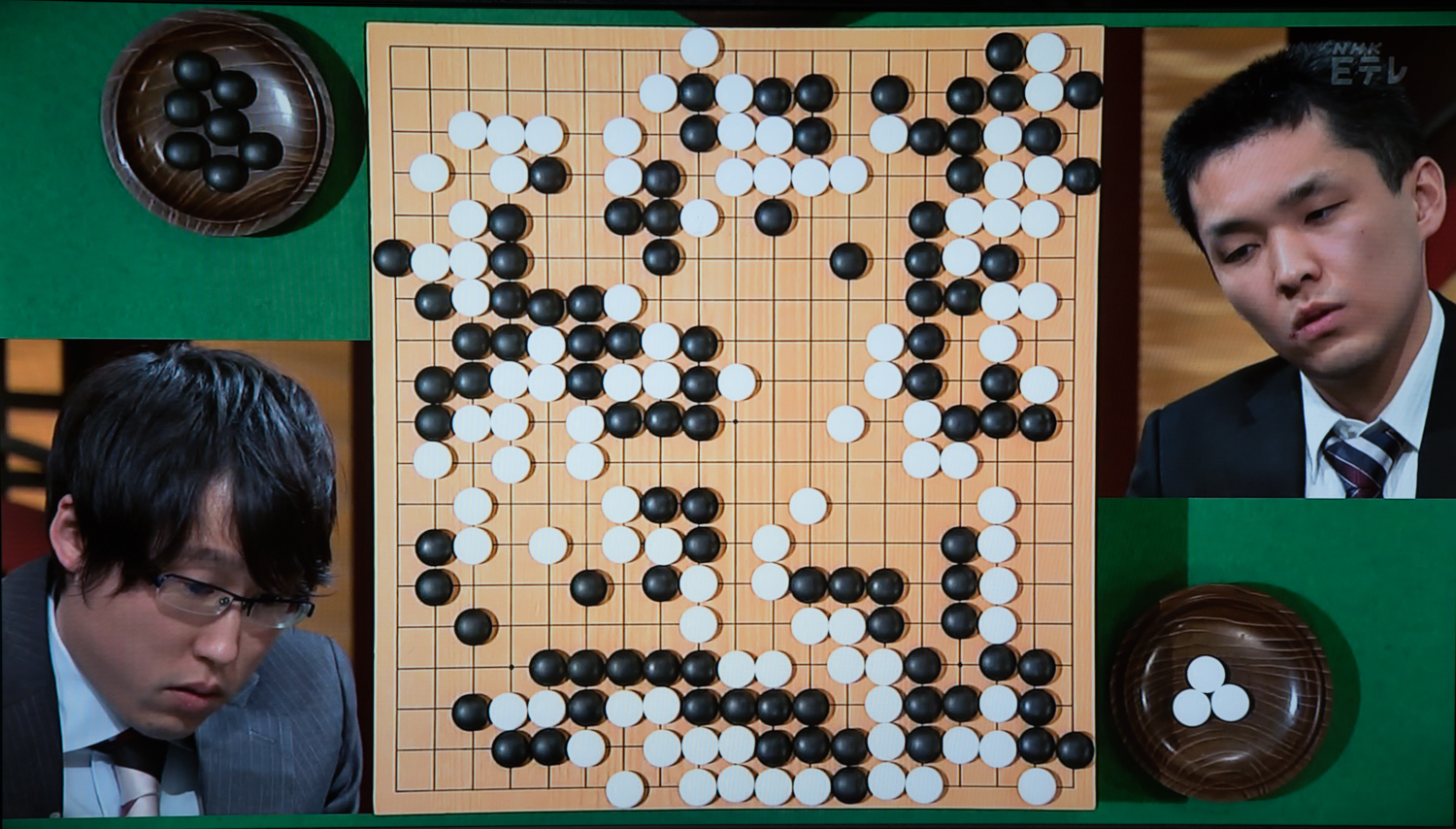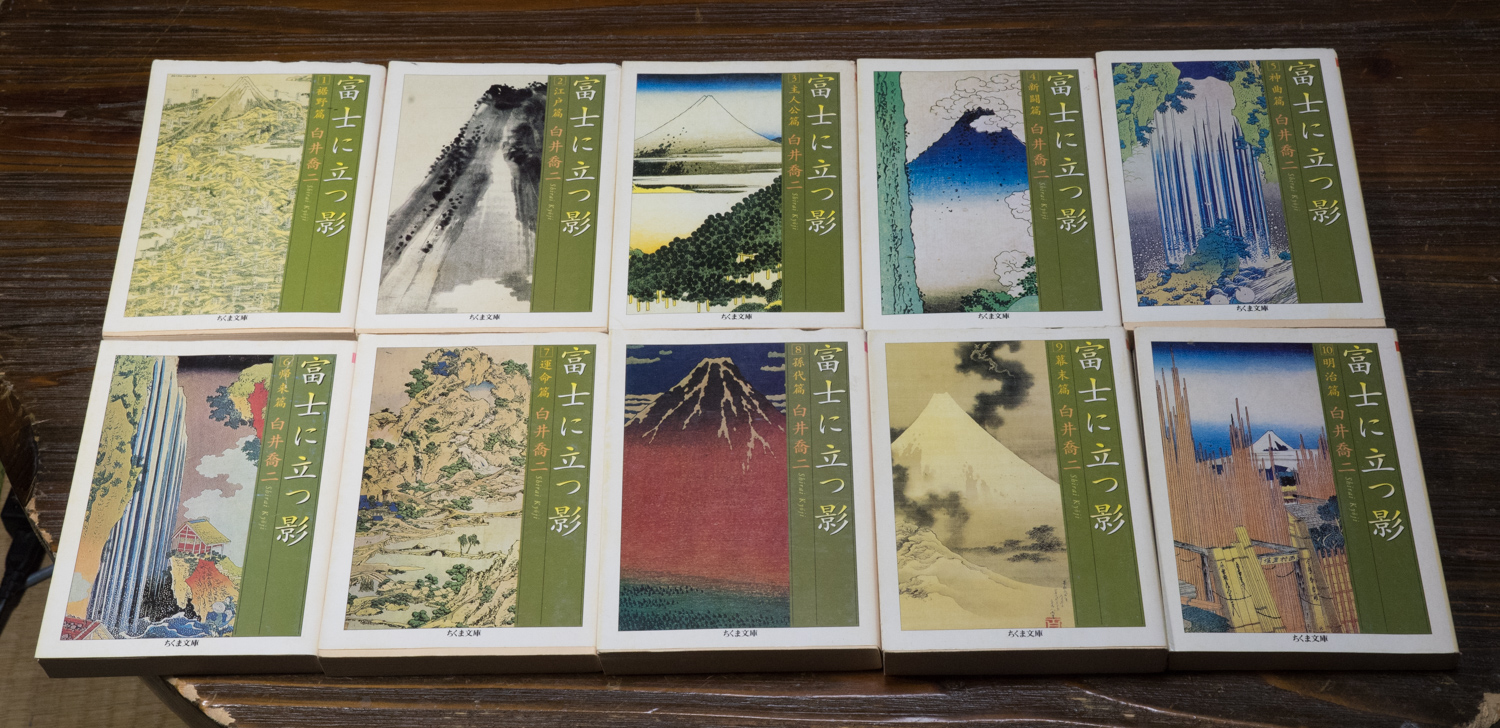 本日のNHK杯戦の囲碁はいよいよ決勝戦、黒番が井山裕太7冠王、白番が志田達哉7段の対戦です。何とこの二人は初対戦とのことで、今の井山7冠王に当たるには、タイトル戦の挑戦者になるしかないということでしょう。またこれまでのNHK杯戦、志田7段はすべて白番で勝ちというこれまた珍しい記録です。布石は志田7段が得意の向かい小目で、ほとんど準決勝と同じような進行になりました。最近AIの影響で三々打ちとか流行っていますが、志田7段はそういうのにまったく影響されず我が道を行って勝ち進んでいます。左下隅の定石で黒が隅に付けていったのに白は手を抜いて右下隅のカカリを急ぎました。黒は白が手を抜いたので出切りを敢行し隅の白2子を取りましたが後手になりました。白は下辺から右下隅を詰め、黒がコスんで白が押して競い合いが始まりました。黒が下辺からの白にハネを打った時、白は伸びないで右辺を打ちました。これに対し黒が当てて叩くのが気持ちいいかと思いましたが井山7冠王はさらに厳しく急所に置いていきました。この後の折衝で結局黒は下辺でポン抜いている白4子を取り込みましたが、その代わり右下隅の黒を封鎖され、隅に一手入れなければならなかったのはちょっと辛かったかもしれません。右上隅は黒地が大きくなりそうなタイミングで白が三々に入り、黒は左側から押さえて白が右辺に食い込むのを許しています。下辺の折衝で先手を取った白は上辺に開き、次に右上隅を封鎖している黒への攻めを見ました。黒は攻められてはたまらないので上辺を開きました。ここで白がその開いた石にコスミツケて利かしにいきましたが、黒はすかさず反発して結局ノゾキを2つ打ち、両方を白に継がせて、ここは黒が上手く打ち回した感じです。黒は続けて左辺に打ち込み、いろいろありましたが、黒は上辺の白地をかなりへこませ、黒が打ちやすい形勢ではなかったかと思います。非勢を感じていた白は下辺で取られている白4子に向かって右下隅から連絡を匂わせる手を打ちました。ここでも黒は反発して。取られていた白4子が復活する代わりに、右下隅の白を切り離すという振り替わりを目指しました。この結果は白が得した感じで、黒は右下隅を取る手を打たずに、左辺の白への攻めを見せ、一部の白を切り離すことに成功し、ここでまた黒のリードとなりました。また右上隅の白には劫が残っており、全体に厚くなった黒は劫を決行しました。白は劫材が続かず、右上隅は活きる手を打たなければなりませんでした。これで盤面10目くらいの黒リードで、このまますんなり黒の勝ちかと思われましたが、真ん中につくかと思った黒地が志田7段の巧妙な手でほとんどなくなり、差はほとんどなくなりました。しかし最後半劫が2つ残りましたが黒はその両方を白に譲って、結局黒の半目勝ちでした。志田7段の健闘が光りました。井山7冠王NHK杯戦2連覇です。2人ともTV囲碁アジア選手権で頑張って欲しいものです。
本日のNHK杯戦の囲碁はいよいよ決勝戦、黒番が井山裕太7冠王、白番が志田達哉7段の対戦です。何とこの二人は初対戦とのことで、今の井山7冠王に当たるには、タイトル戦の挑戦者になるしかないということでしょう。またこれまでのNHK杯戦、志田7段はすべて白番で勝ちというこれまた珍しい記録です。布石は志田7段が得意の向かい小目で、ほとんど準決勝と同じような進行になりました。最近AIの影響で三々打ちとか流行っていますが、志田7段はそういうのにまったく影響されず我が道を行って勝ち進んでいます。左下隅の定石で黒が隅に付けていったのに白は手を抜いて右下隅のカカリを急ぎました。黒は白が手を抜いたので出切りを敢行し隅の白2子を取りましたが後手になりました。白は下辺から右下隅を詰め、黒がコスんで白が押して競い合いが始まりました。黒が下辺からの白にハネを打った時、白は伸びないで右辺を打ちました。これに対し黒が当てて叩くのが気持ちいいかと思いましたが井山7冠王はさらに厳しく急所に置いていきました。この後の折衝で結局黒は下辺でポン抜いている白4子を取り込みましたが、その代わり右下隅の黒を封鎖され、隅に一手入れなければならなかったのはちょっと辛かったかもしれません。右上隅は黒地が大きくなりそうなタイミングで白が三々に入り、黒は左側から押さえて白が右辺に食い込むのを許しています。下辺の折衝で先手を取った白は上辺に開き、次に右上隅を封鎖している黒への攻めを見ました。黒は攻められてはたまらないので上辺を開きました。ここで白がその開いた石にコスミツケて利かしにいきましたが、黒はすかさず反発して結局ノゾキを2つ打ち、両方を白に継がせて、ここは黒が上手く打ち回した感じです。黒は続けて左辺に打ち込み、いろいろありましたが、黒は上辺の白地をかなりへこませ、黒が打ちやすい形勢ではなかったかと思います。非勢を感じていた白は下辺で取られている白4子に向かって右下隅から連絡を匂わせる手を打ちました。ここでも黒は反発して。取られていた白4子が復活する代わりに、右下隅の白を切り離すという振り替わりを目指しました。この結果は白が得した感じで、黒は右下隅を取る手を打たずに、左辺の白への攻めを見せ、一部の白を切り離すことに成功し、ここでまた黒のリードとなりました。また右上隅の白には劫が残っており、全体に厚くなった黒は劫を決行しました。白は劫材が続かず、右上隅は活きる手を打たなければなりませんでした。これで盤面10目くらいの黒リードで、このまますんなり黒の勝ちかと思われましたが、真ん中につくかと思った黒地が志田7段の巧妙な手でほとんどなくなり、差はほとんどなくなりました。しかし最後半劫が2つ残りましたが黒はその両方を白に譲って、結局黒の半目勝ちでした。志田7段の健闘が光りました。井山7冠王NHK杯戦2連覇です。2人ともTV囲碁アジア選手権で頑張って欲しいものです。
日: 2018年3月18日
Public romance in Japan (7) – Kyoji Shirai’s “Fuji ni tatsu kage”
 Let me introduce today Kyoji Shirai’s best romance, “Fuji ni tatsu kage” (“富士に立つ影”, a shadow standing on Mr. Fuji). This romance is not only his best work, but also a big milestone in the history of public romance, or even in all Japanese literature, I should say. The three greatest works in public romance are, “Dai Bosatsu Touge”, “Musashi” (“宮本武蔵”) of Eiji Yoshikawa (“”吉川英治”), and this work.
Let me introduce today Kyoji Shirai’s best romance, “Fuji ni tatsu kage” (“富士に立つ影”, a shadow standing on Mr. Fuji). This romance is not only his best work, but also a big milestone in the history of public romance, or even in all Japanese literature, I should say. The three greatest works in public romance are, “Dai Bosatsu Touge”, “Musashi” (“宮本武蔵”) of Eiji Yoshikawa (“”吉川英治”), and this work.
This romance was serialized in the newspaper “Hochi” (“報知新聞”) from July 1924 through July 1927, for more than 1,000 times. (Novels serialized in newspapers are still popular in Japan, but the average period of continuance is just around a half year.) There are ten volumes (also chapters) in Japanese paper book style, as you can see in the photo. The names of ten parts are, 1. Susono-hen (Chapter of the plain at the foot of Mt. Fuji), 2. Edo-hen (Chapter of Edo city), 3. Shujinko-hen (Chapter of the central character), 4. Shinto-hen (Chapter of a new battle), 5. Shinkyoku-hen (Chapter of Divine Comedy), 6. Kirai-hen (Chapter of coming back to Mt. Fuji), 7. Unmei-hen (Chapter of destiny), 8. Sondai-hen (Chapter of grandsons’ generation), 9. Bakumatsu-hen (Chapter of the end of Edo period), and 10. Meiji-hen (Chapter of Meiji period). The romance was sold for more than 3 million copies.
Let me introduce now basic story of this romance. To make a long story (literally) short, this romance describes 68 years’ (1805 – 1873) battles between two families of castle builders, during three generations, namely fathers, sons, and grandsons. The author said that he described “war and peace” based on humanity. The story starts when Tokugawa shogunal government planned to build a new castle in the plain at the foot of Mt. Fuji for the training of their subordinate soldiers in western style. The government summoned two engineers, namely Kikutaro Sato (“佐藤菊太郎”), as a representative of Sanshi-ryu (“賛四流”) school of castle building, and Hakuten Kumaki (“熊木伯典”), as one of Sekishin-ryu (“赤針流”), another dominant school of castle building. The government tries to determine the chief designer of the new castle by the competition between two schools. Until this work, most public romance used fighting by Japanese swords (Chambara) to solve the conflict between two parties. This work, however, adopted debates between two engineers, which was, and still is, a brand-new style. Kikutaro is a young, talented, and honest guy. Hakuten, an older guy, on the other hand, plays very dirty. Most readers expected the victory of Kikutaro, a white-hat, but the author betrays the readers’ expectation, which is very rare in public romance.
The actual hero of this romance appears at first only from the chapter three. The hero, Kimitaro Kumami (“熊木公太郎”) is the son of Hakuten, a quite evil guy. The son, however, is completely different from his father. He is quite honest, decent, always trying to protect the weak, and at the same time a little bit foolish. A critic compared him with Prince Myshkin in Dostoyevsky’s novel “The Idiot”. Both of them are, so to say, holy idiots. This character is quite new and different from the cruel, nihilistic character of “Ryunosuke Tsukue” in “Dai Bosatsu Touge”. This hero brought the romance into a big success, because many readers really loved the character of Kimitaro. In parallel to Kimitaro, Heinosuke Sato (“佐藤兵之助”), the son of Kikutaro, is described as a very smart, bureaucratic type, but rather cruel guy. This is quite a surprising twist that the good side and the evil side turn over in the second generation.
One English teacher at Eigox told me when I introduced this romance to him that this romance sounds similar as Frank Herbert’s “Dune”, which also describes the battles between two families, namely between the Atreides and the Harkonnens. In Dune, however, the Harkonnes are always described as the evil side. In Fuji ni tatsu kage, we cannot simply say that one side is good and the other is bad, and do not know until the end of the story how the battles between two families are settled. There is also a “Romeo and Juliet” type affair between the two families, which makes the story more complex and attractive. In such viewpoints, this romance goes far beyond the realm of usual public romance. Kyoji Shirai aimed at such a high-level literature even the genre was classified as public romance, which was usually considered as vulgar literature.
It is absolutely impossible to describe all charm of this romance here. I strongly hope that this novel will be translated into English for foreign readers someday.
